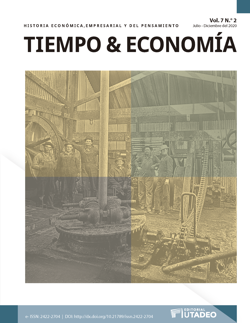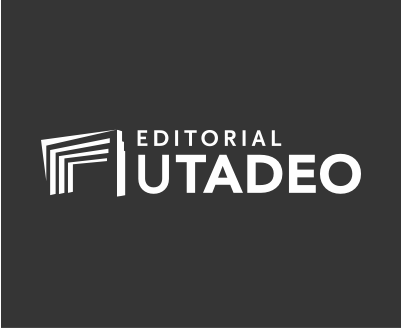Esta obra está bajo una licencia internacional Creative Commons Atribución-NoComercial-CompartirIgual 4.0.
Resumen
En las últimas décadas tomó forma en la historiografía de la historia económica asiática y occidental un nuevo consenso que registra intensificación del trabajo y del consumo, respectivamente. Estos procesos, denominados revolución industriosa, tuvieron lugar tanto en Asia del Este como en Europa en los siglos previos a la Revolución Industrial. Este artículo pretende mostrar la forma en que la plata americana incidió en ambos procesos, los cuales constituyeron el rasgo característico de la primera globalización. Para ello, se recurrirá al análisis de aportes actuales de la historia económica global.
Citas
Barrett, W. (1990). World bullion flows, 1450-1800. En J. D. Tracy (ed.). The Rise of Merchant Empires: Long Distance Trade in the Early Modern World 1350-1750 (pp. 224-254). Cambridge University Press. https://doi.org/10.1017/CBO9780511563089.010
Bentley, J. H., Subrahmanyam, S., & Wiesner-Hanks, M. E. (2015). The Cambridge World History (vol. 6). Cambridge University Press. https://doi.org/10.1017/CBO9781139022460
Bonialian, M. A. (2012). El pacífico hispanoamericano: Política y comercio asiático en el imperio español (1680-1784). El Colegio de México AC.
Bonialian, M. A., & Hausberger, B. (2018). Consideraciones sobre el comercio y el papel de la plata hispanoamericana en la temprana globalización, siglos XVI-XIX. Historia mexicana, 68(1), 197-244. https://doi.org/10.24201/hm.v68i1.3641
Borge-López, F. J. (2003). Richard Hakluyt, promoter of the New World: The navigational origins of the English nation. Sederi: yearbook of the Spanish and Portuguese Society for English Renaissance Studies, 13, 1-15.
Broadberry, S. (2013). Accounting for The Great Divergence. Economic History Working Papers, 184, 1-33. http://eprints.lse.ac.uk/54573/1/WP184.pdf
Cullen, L. (2006). Tokugawa Population: The Archival Issues. Japan Review, 18, 129-180.
De-Leguina y Vidal, E. (1894). La plata española: Apuntes reunidos. F. Fé.
Desaulty, A.-M., Telouk, P., Albalat, E., & Albarède, F. (2011). Isotopic Ag–Cu–Pb record of silver circulation through 16th–18th century Spain. Proceedings of the National Academy of Sciences, 108(22), 9002–9007. https://doi.org/10.1073/pnas.1018210108
De-Vries, J. (1994). The industrial revolution and the industrious revolution. The Journal of Economic History, 54(2), 249-270. https://doi.org/10.1017/S0022050700014467
Deng, K., & O’brien, P. (2015). Nutritional Standards of Living in England and the Yangtze Delta (Jiangnan), circa 1644-circa 1840: Clarifying Data for Reciprocal Comparisons. Journal of World History, 233-267. https://doi.org/10.1353/jwh.2016.0039
De-Pleijt, A. M., & Van-Zanden, J. L. (2016). Accounting for the “Little Divergence”: What drove economic growth in pre-industrial Europe, 1300-1800? European Review of Economic History, 20(4), 387-409. https://doi.org/10.1093/ereh/hew013
De-Vito, C. G., & Gerritsen, A. (2017). Micro-spatial histories of global labour. Springer. https://doi.org/10.1007/978-3-319-58490-4
Diccionario Panhispánico de Dudas. (s/f). Yangtsé. http://lema.rae.es/dpd/srv/search?id=f1cZU8ucgD67Nrxu5D
Dillon, M. (1976). A history of the porcelain industry in Jingdezhen. University of Leeds.
Domínguez-Ortiz, A, M. V. (1997). Prólogo. En Historia del real de a ocho. EDITUM.
Esherick, J. W., & Backus-Rankin, M. (eds.). (1990). Chinese Local Elites and Patterns of Dominance. University of California Press.
Flynn, D. O. (2015). Silver in a global context, 1400-1800. En The Cambridge World History (vol. VI). Cambridge University Press. https://doi.org/10.1017/CBO9781139022460.010
Flynn, D. O., & Giráldez, A. (1995). Born with a “silver spoon”: The origin of world trade in 1571. Journal of World History, 6(2), 201-221.
Folch, D., Zialcita, F., Qi, H., & Yuste, C. (2013). Los orígenes de la globalización: El galeón de Manila. Biblioteca Miguel de Cervantes, Shanghái.
Gerritsen, A., & McDowall, S. (2012). Global China: Material culture and connections in world history. Journal of World History, 3–8. https://doi.org/10.1353/jwh.2012.0008
Grau y Monfalcón, J. (1640). Iustificacion de la conseruacion, y comercio de las Islas Filipinas.: Al illustrmo. y Reuermo. señor. don Iuan de Palafox y Mendoza del Consejo de Su Magestad en el Real de las Indias, obispo de la Puebla de los Angeles [Madrid: s.n.]. http://archive.org/details/iustificaciondel00grau
Hamashita, T. (2017). The tribute trade system and modem Asia. En The Pacific in the Age of Early Industrialization (pp. 133-151). Routledge. https://doi.org/10.4324/9781315237923-6
Hamilton, E. J. (1929). Imports of American gold and silver into Spain, 1503-1660. The Quarterly Journal of Economics, 43(3), 436-472. https://doi.org/10.2307/1885920
Hayami, A. (1986). A Great Transformation: Social and Economic Change in Seventeenth Century in Japan. Bonner Zeitschrift für Japanalogie, 8, 3-13.
Hayami, A. (2015). Japan’s Industrious Revolution: Economic and Social Transformations in the Early Modern Period. Springer. https://doi.org/10.1007/978-4-431-55142-3_5
Holohan, K. E. (2020). Una merienda global: The Americas and China at the Early Modern Spanish Table. Bulletin of Spanish Studies, 1-29. https://doi.org/10.1080/14753820.2020.1699324
Internet Modern History Sourcebook (s/f). Qinglong’s Letter to King George. http://academics.wellesley.edu/Polisci/wj/China/208/READINGS/qianlong.html
Irigoin, A. (2018). Global silver: Bullion or specie? Supply and demand in the making of the early modern global economy. Economic History Working Papers, 285, 1-42. http://eprints.lse.ac.uk/90190/1/WP285.pdf
Li, B. (2005). Farm labour productivity: China. En Living Standards in the Past New Perspectives on Well-Being in Asia and Europe (pp. 55-76). Oxford University Press. https://doi.org/10.1093/0199280681.003.0003
Li, B. (2008). Chinese Economic History in a New Perspective: Focusing on the Late Imperial Rural Economy in Jiangnan. Pacific Economic Review, 13(3), 308-319. https://doi.org/10.1111/j.1468-0106.2008.00406.x
Ma, D. (2008). Economic growth in the lower Yangzi region of China in 1911-1937: A quantitative and historical analysis. The Journal of Economic History, 68(2), 355-392. https://doi.org/10.1017/S002205070800034X
Maddison. A. (2004). La economía de Occidente y la del resto del mundo en el último milenio. Revista de Historia Económica, 2, 259-336. http://hdl.handle.net/10016/2764 https://doi.org/10.1017/S0212610900011034
Ming, W. (2017). The Monetization of Silver in China: Ming China and Its Global Interactions. En M. D. Elizalde and J. Wang (eds.). China’s Development From A Global Perspective (pp. 274-296). Cambridge Scholars Publishing.
Noblett, C. K., & López, M. S. (2018). Ornato y Menaje «De la China del Japón» en la España De Felipe V e Isabel De Farnesio (1700-1766). Cuadernos dieciochistas, 19, 9-51. https://doi.org/10.14201/cuadieci201819951
Palma, N., & Silva, A. C. (2017). Spending a windfall: American precious metals and Euro-Asian trade 1531-1810. GGDC Research Memorandum, 165, http://dx.doi.org/10.2139/ssrn.2877128
Pomeranz, K. (2000). The Great Divergence: China, Europe, and the Making of the Modern World Economy. Princeton University Press. https://doi.org/10.1515/9781400823499
Rosenthal, J. L., & Wong, R. B. (2011). Before and beyond divergence. Harvard University Press. https://doi.org/10.4159/harvard.9780674061293
Saito, O. (2005). Pre-modern economic growth revisited: Japan and the West (London School of Economics, working paper 16/05). http://www.lse.ac.uk/Economic-History/Assets/Documents/Research/GEHN/GEHNWP16-OS.pdf
Saito, O. (2015). Growth and inequality in the great and little divergence debate: A Japanese perspective. The Economic History Review, 68(2), 399-419. https://doi.org/10.1111/ehr.12071
Saito, O., & Takashima, M. (2015). Estimating the shares of secondary- and tertiary-sector output in the age of early modern growth: the case of Japan, 1600-1874 (RCESR Discussion Paper Series No. DP15-4). http://risk.ier.hit-u.ac.jp/English/pdf/dp15-4_rcesr.pdf
Saito, O. (2016). Japan. En J. Baten (ed.). A history of the global economy (167-187). Cambridge University Press. https://doi.org/10.1017/CBO9781316221839.006
Skinner, G. W., & Baker, H. D. (1977). The city in late imperial China. Stanford University Press.
Smith, T. C. (1973). Pre-modern economic growth: Japan and the West. Past & Present, 60, 127-160. https://doi.org/10.1093/past/60.1.127
Smith, T. C. (1989). Native Sources of Japanese Industrialization, 1750-1920 (1st edition). University of California Press.
Smitka, M. (2001). Japanese Economic History 1600-1960. Routledge.
Stein, S. J., & Stein, B. H. (2000). Silver, trade, and war: Spain and America in the making of early modern Europe. JHU Press.
Subrahmanyam, S. (2012). The Portuguese Empire in Asia, 1500-1700: A Political and Economic History. John Wiley & Sons. https://doi.org/10.1002/9781118496459
Sugihara, K. (2004a). The East Asian path of economic development: A long-term perspective. En The Resurgence of East Asia (pp. 92-137). Routledge.
Sugihara, K. (2004b). The state and the industrious revolution in Tokugawa Japan. (London School of Economics, working paper 02/04). http://www.lse.ac.uk/Economic-history/Assets/Documents/Research/GEHN/GEHNWP02KS.pdf
Sugihara, K. (2007). The second Noel Butlin lecture: Labour‐intensive industrialisation in global history. Australian Economic History Review, 47(2), 121-154. https://doi.org/10.1111/j.1467-8446.2007.00208.x
Sugihara, K. (2015). La segunda conferencia de “Noel Butlin”: La industrialización de trabajo intensivo en la historia global. Revista Escuela de Historia, 14(2). http://www.rehunsa.com/revista14v02-traduccion.htm
Taylor, E. G. R. (2017). The Original Writings and Correspondence of the Two Richard Hakluyts: Volumes I-II. Routledge. https://doi.org/10.4324/9781315554914
Tepaske, J. J. (2010). A new world of gold and silver. Brill. https://doi.org/10.1163/ej.9789004188914.i-342
Van-Zanden, J. L. (2009). The long road to the industrial revolution: The European economy in a global perspective, 1000-1800 (vol. 1). Brill. https://doi.org/10.1163/ej.9789004175174.i-346
Vilaplana-Persiva, M. (1997). Historia del real de a ocho. EDITUM.
Von-Glahn, R. (1996). Fountain of fortune: Money and monetary policy in China, 1000-1700. University of California Press.
Von-Glahn, R. (2012a). Cycles of silver in Chinese monetary history. En B. K. Long-So (ed.). The Economy of Lower Yangzi Delta in Late Imperial China (pp. 33-87). Routledge.
Vries, P. (2010). The California School and Beyond: How to Study the Great Divergence? History Compass, 8(7), 730-751. https://doi.org/10.1111/j.1478-0542.2010.00698.x
Wallerstein, I. (2005). After developmentalism and globalization, what? Social Forces, 83(3), 1263-1278. https://doi.org/10.1353/sof.2005.0049
Wikipedia (2017). Jiangnan. https://es.wikipedia.org/w/index.php?title=Jiangnan&oldid=103831790
Wikipedia (2018). Yangtsé. https://es.wikipedia.org/w/index.php?title=Yangts%C3%A9&oldid=110601504
Wong, R. B. (1997). China transformed: Historical change and the limits of European experience. Cornell University Press.

 PDF
PDF
 FLIP
FLIP
 XML
XML












